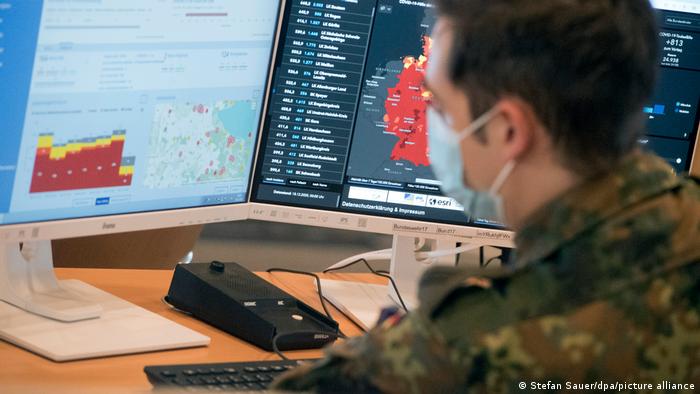The COVID-19 infection figures reported every day by Germany’s public health agency, the Robert Koch Institute (RKI), continue to decline. The number of infections per 100,000 inhabitants within seven days, the so-called incidence rate, stands at just over 200. The fourth wave of the pandemic — which saw infections with the delta variant — is subsiding.
But falling numbers may also be attributable to the fact that fewer people were tested over the Christmas holidays.Schools and many companies are closed during the festive season, and many workers take time off. This also applies to employees of the local health authorities, which then find themselves unable to provide updated figures every day.
Speaking in Berlin on Wednesday, Health Minister Karl Lauterbach said Germany’s seven-day incidence was likely “two or three times as high” as the current reported rate of 205 cases per 100,000 people. “I do not believe the drop in the overall case numbers to be sustainable. And we’ll have to react to that,” Lauterbach said.
A Health Ministry spokesperson said more reliable figures would be available again at the beginning of 2022. However, he said, it would take a few days for follow-up reports to be processed.
In Germany, health policy is the responsibility of the 16 state governments. There are some 400 health offices in Germany, and their staffing situation and level of digitalization varies vastly.
Complex situation
Cottbus, a city of 100,000 inhabitants a 90-minute drive from Berlin, is currently a COVID-19 hotspot, reporting especially high infection rates. City government spokesman Jan Glossmann says that the health office has continued working right through Christmas.
“We had an additional 74 people deployed to our health office,” Glossmann said. “They were dispatched to us from health offices in other towns, and also included 25 Bundeswehr soldiers who helped us keep up to date.”
The city’s COVID-19 dashboard has been updated daily without interruption, Glossmann said, adding that all infection figures had been reported to the RKI.
Not far from Cottbus, in the district of Oberspreewald-Lausitz, the health department has also been operating nonstop, with the exception of Christmas weekend. However, a district official pointed out, that at the end of the year many clinics are closed as doctors and medical workers are on vacation. Also, not all laboratories are fully staffed. “If the laboratories don’t process any samples, there are no case reports that can be passed on by the health department,” said the local official.
The city-state of Bremen has the highest vaccination rate in Germany. There, also the health department is managing to do its job. “All those who have tested positive, as well as their identified contacts, are being informed,” the head of the health department, Jörn Moog, told DW. “Due to the increasing number of infections, we have brought in more people to process the reports.” However, he said, most doctors can not yet access the official reporting system of the Robert Koch Institute. “So they still report new infections to us by fax or as an encrypted email attachment, and we take over the data entry.”
A year ago, the situation was similar: It wasn’t until mid-January that the figures were reliable again.
Not just a holiday problem
Even before Christmas, many health offices reported that they were overwhelmed. Ute Teichert, chairwoman of the Federal Association of Public Health Offices, told the media network RND that in many places contact tracing was no longer possible. “So those who are tested positive have to make sure that they act responsibly and inform all the people they might have infected,” s he said. “Citizens often get no advice from the health department, but have to read up on the quarantine and behavioral rules for themselves.”
And now the spread of the much more contagious omicron variant is expected to exacerbate the situation. “Health departments have to order the infected and their contacts to quarantine, but, unlike with the less-contagious delta variant, this will apply to everybody regardless of the individual’s vaccination status,” Teichert slad.
The health offices will need significantly more permanent specialized staff to ensure continuity. Short-term support from volunteers or soldiers or other public service employees is inefficient in the long term, Teichert pointed out.
“We have found ourselves constantly having to train new people, set up new work spaces and organize equipment, and, after a few weeks, when the numbers go down, everything is cut back again,” Teichert said.
On January 7, Chancellor Olaf Scholz and the state premiers will meet again to discuss the situation and possibly decide on new measures to curb the spread. This would be very difficult if the data situation were still unclear.
This article has been translated from German.
While you’re here: Every Tuesday, DW editors round up what is happening in German politics and society. You can sign up here for the weekly email newsletter Berlin Briefing, to stay on top of developments as Germany enters the post-Merkel era.
COVID figures in Germany may be much higher than reported
Source: Pinoy Pop News

0 Comments